Decision Micro Classroom Issue 35: SAP iRPA heavy dry goods sharing!
 Time: 2021-05-25
Time: 2021-05-25  Views: 1292
Views: 1292
▼[Decision Micro Classroom] The 35th issue of SAP iRPA helps enterprises reduce costs and increase efficiency. It ended perfectly at 22:00 in the evening on May 25, 2021, with warm praise from people in the SAP industry. Everyone responded enthusiastically and benefited a lot. .
▼In order to facilitate further learning and sharing, we have organized and summarized the content of this issue and formed dry information for everyone. We hope that everyone can continue to charge and improve, and continue to accelerate on the path of our beloved SAP career.
Introduction to this issue’s guests: Gartner pointed out: RPA is an important strategic technology trend in 2021. Unlike other traditional IT projects, RPA can realize business value for enterprises. In the wave of digital transformation, RPA not only helps employees improve output efficiency, meets high standards for accuracy and compliance of work results, and improves operational efficiency.
Gartner pointed out: RPA is an important strategic technology trend in 2021. Unlike other traditional IT projects, RPA can realize business value for enterprises. In the wave of digital transformation, RPA not only helps employees improve output efficiency, meets high standards for accuracy and compliance of work results, and improves operational efficiency.
1. Digital workforce: RPA
Generally speaking, RPA automates some manual operations, including keyboard and mouse operations, such as business operations with high repetitiveness and low added value, thereby accelerating the digital transformation of our business processes. According to the execution mode of RPA robots, it can be divided into three different types:
■ Unattended (digital employee): No human intervention is required, and it can complete tasks assigned to it by the enterprise completely independently and on time.
■ Manned assistant (digital assistant): Collaborate with humans to complete a task, and can start the RPA robot process on demand according to a need of the enterprise.
■ Intelligent duty (hyper-automated employees): By adding artificial intelligence technology to the digital workforce (RPA), robots can learn autonomously based on historical execution data and realize the connection between robots.
2. The expected benefits that SAP iRPA solution brings to enterprises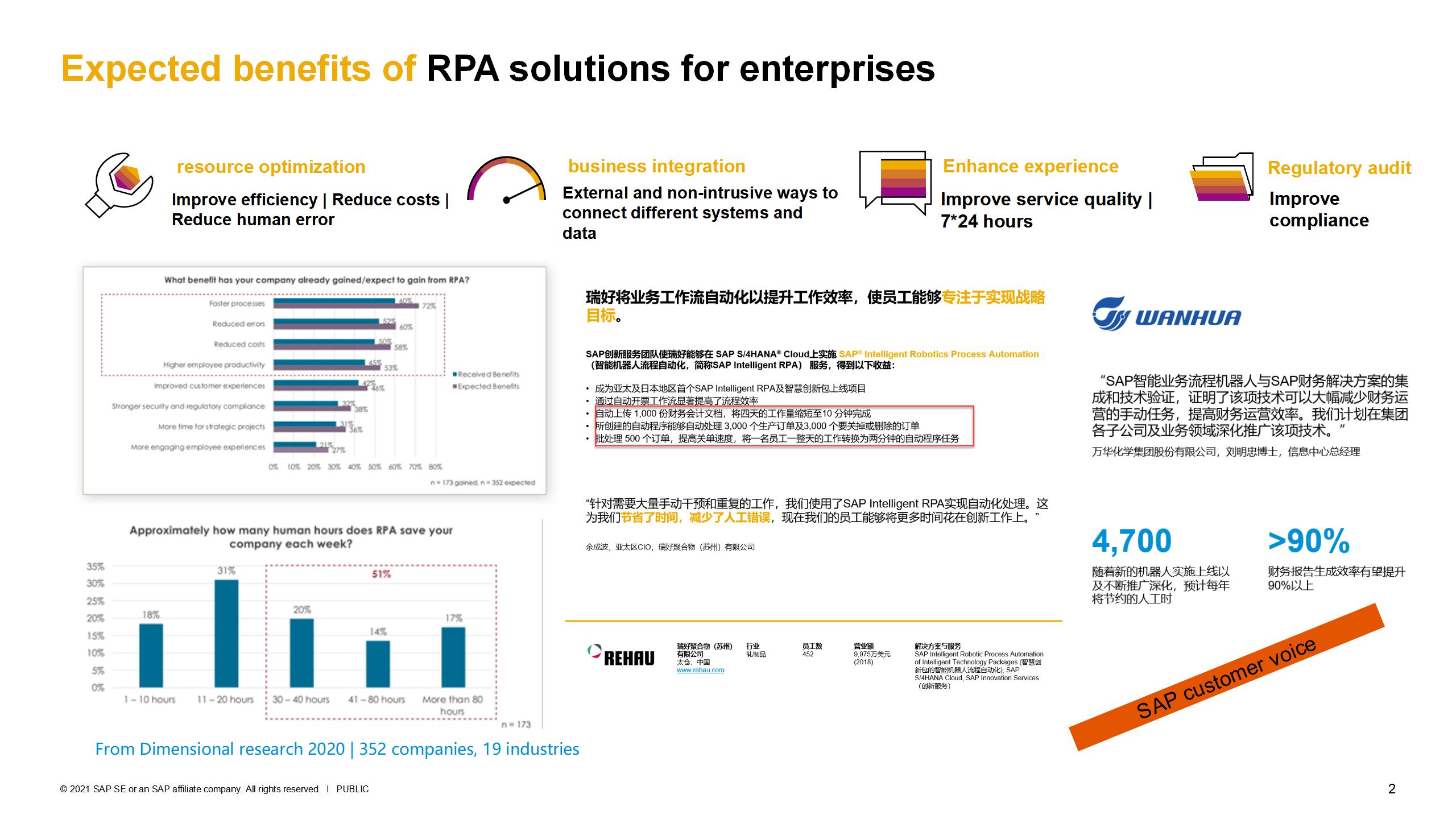
What expected benefits can the SAP iRPA solution bring to enterprises? Mainly summarized into four aspects:
■ Optimization of corporate human resources: It can help humans handle work, freeing corporate labor to do other more valuable work. At the same time, robots can perform more efficiently and make fewer errors. On the one hand, they reduce labor costs, and on the other hand, they bring To improve work efficiency, we achieve comprehensive optimization of resources.
■ Can realize external connection: a non-invasive way to help enterprises connect systems and data without investing a lot of cost through backend program or interface development to connect system data.
■ Improve user experience: Front-end business can be on duty 24 hours a day through RPA robots to respond to user needs in real time, thereby improving the company's service quality.
■ Standardized auditing: Execute work according to the logical rules designed by the enterprise to avoid any errors caused by external interference. In addition, the execution status of the robot can be recorded in the system, thus improving the efficiency of standardized auditing by the enterprise.
3.SAP iRPA usage area—Shared Service Center
As shown in the figure above, we can see that whether it is shared service process management, financial sharing center, human resources shared services, etc., due to the large amount of data in these fields, clear transaction processing logic is required, and SAP iRPA has very We can highly summarize the scenarios applicable to these fields into four keywords:
■ High repetition: sort out a logical processing rule.
■ Super large amount: When the volume of business process data or execution is large enough and relatively frequent, RPA can be used for automated processing to ensure relatively high input and output.
■ Cross-system: Support enterprises to complete automated business processes across systems and platforms.
■ Multiple integration: When the investment in hardware integration is very large, it is recommended to use RPA to connect soft systems and data.
4.SAP intelligent business process robot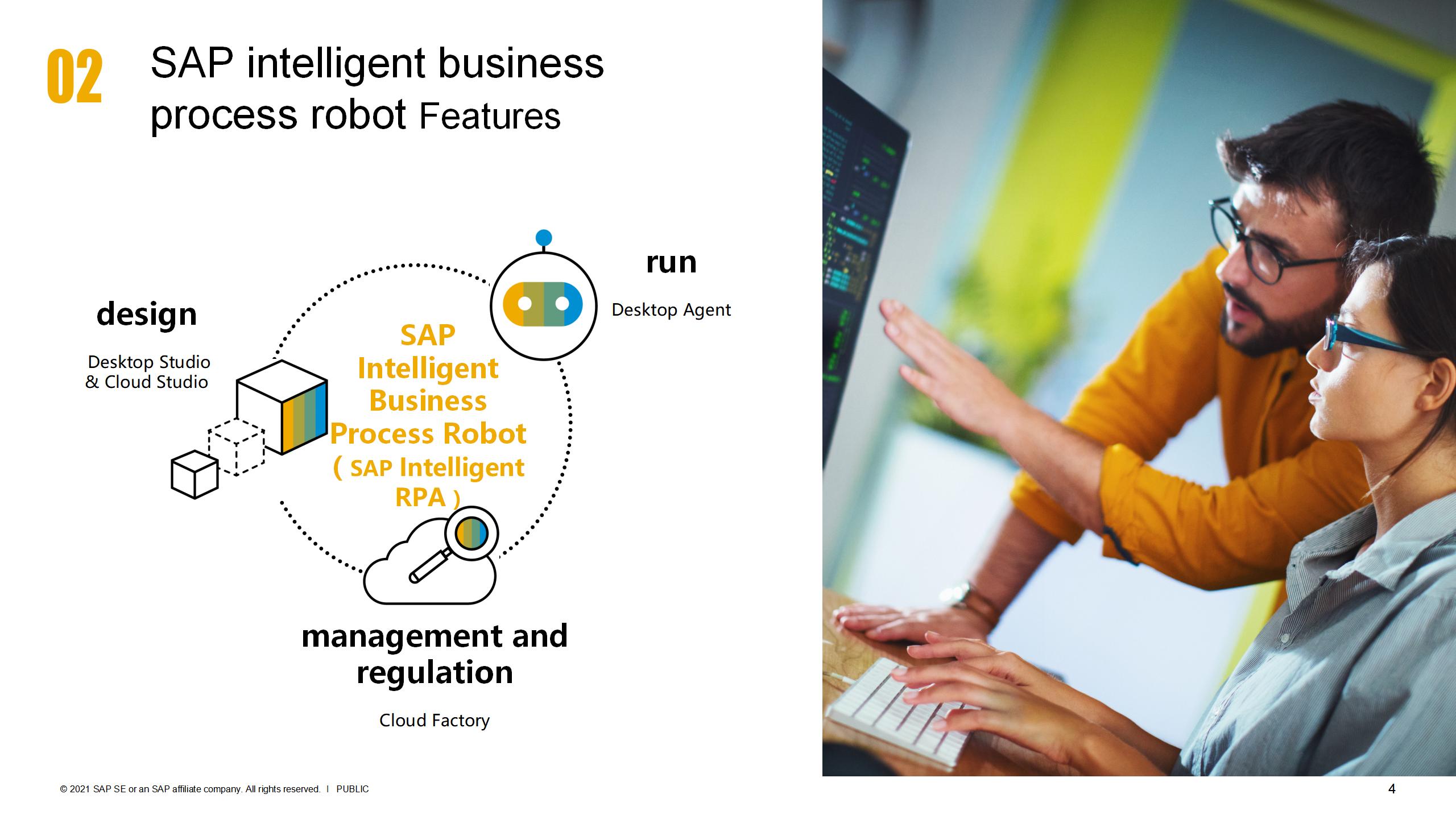
SAP intelligent business process robots mainly cover three core components, which are divided based on a process of implementation and delivery of the entire RPA project:
■ Design side: There is both a desktop development studio installed on the designer’s desktop and a cloud development studio integrated into the cloud robot factory, which further reduces the difficulty of our design.
■ Running end: The desktop execution agent executes according to the demand process set by the enterprise. Whether it is an unattended mode that is started regularly or an attended mode that is started on demand, it can imitate human operations to execute business processes.
■ Management and supervision: Centralized management and supervision of robot execution is called Cloud Robot Factory, which is a SaaS application hosted on the SAP platform.
5.SAP intelligent business process robot technology architecture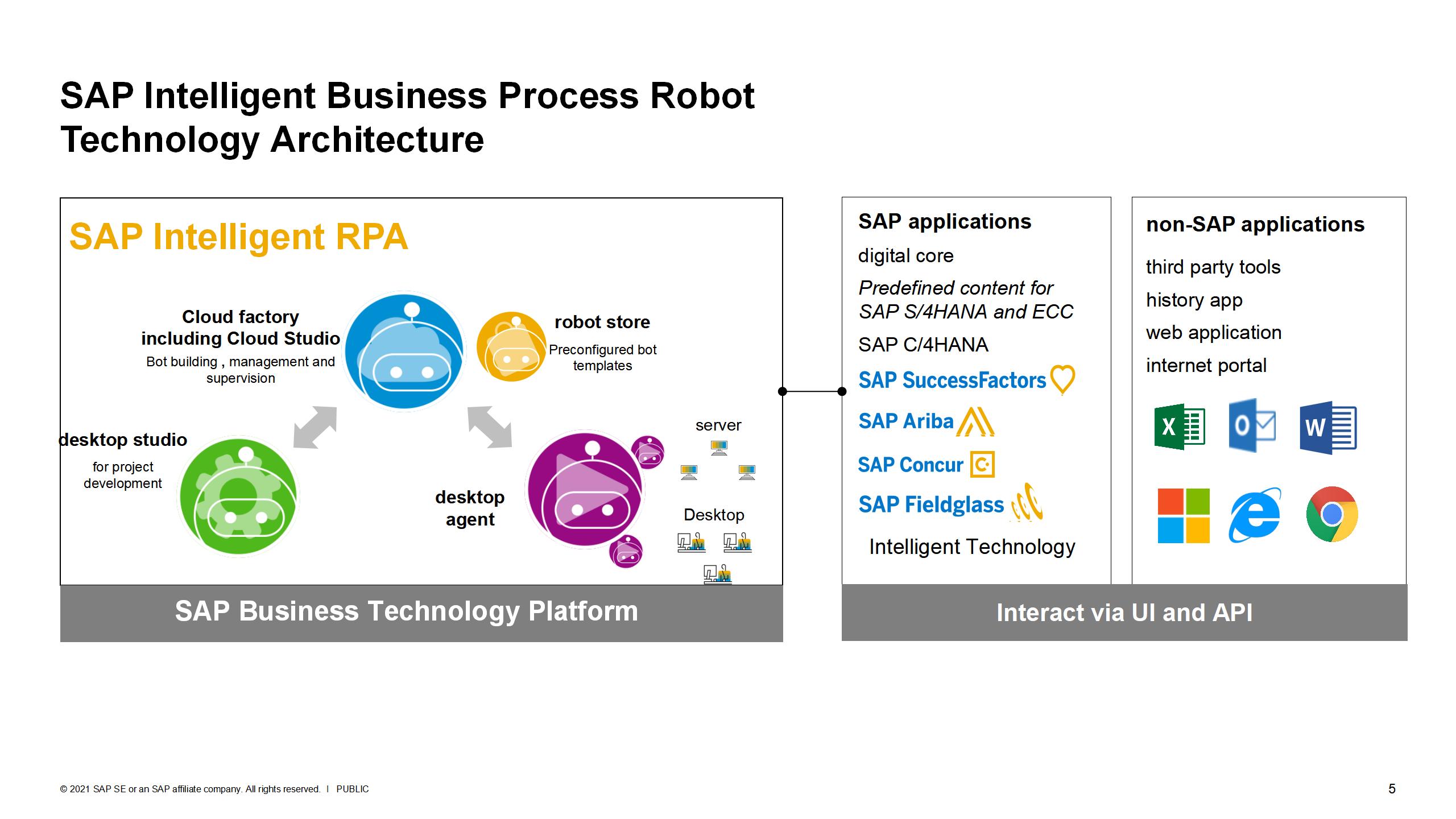
The fourth point introduced that the SAP intelligent business process robot is composed of three core components. You can see an architecture of RPA itself in the right frame of the above figure. Simply put, it is a business process that is used as a tool to automate processing, through the UI Interact with APIs and enterprise target programs, such as SAP applications S/4HANA, C/4HANA, etc., non-SAP application third-party tools, the Internet, etc. For Microsoft office application software, by integrating the SDK into RPA, the operation can be performed by calling the SDK without UI capture.
6. Standard RPA template (170+ robots)
The predefined RPA template has successfully launched more than 170 different business process robots, and the predefined RPA is continuously improved and enriched. As shown in the figure above, it covers multiple business lines, including sales, production, supply chain, finance, etc., according to Based on customer usage statistics, these are very typical RPA scenarios.
7. How SAP RPA business applications help various departments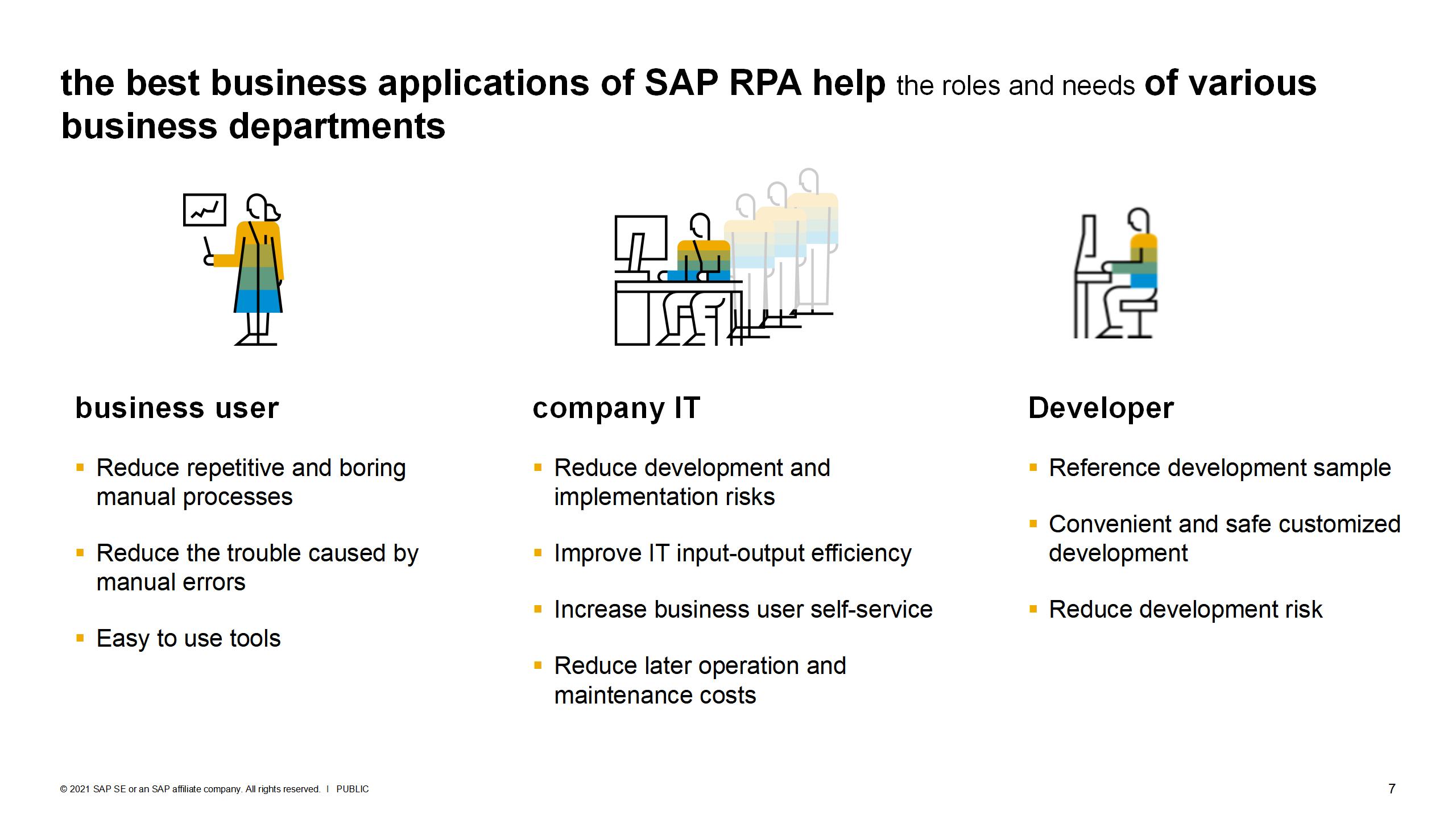 Through the predefined RPA templates of the SAP Robot Store, how SAP iRPA business applications can help enterprises reduce costs and increase efficiency, as shown in the figure above, is mainly divided into three major roles and needs:
Through the predefined RPA templates of the SAP Robot Store, how SAP iRPA business applications can help enterprises reduce costs and increase efficiency, as shown in the figure above, is mainly divided into three major roles and needs:
■ Business users: Predefined RPA templates can be used to reduce repetitive and boring manual processes and reduce the trouble caused by manual errors. The simple operation of the same tool can make it easy for users to get started quickly.
■ Company IT department: It can greatly reduce development and implementation risks and improve the input-output efficiency of the entire IT. With such predefined templates, many scenarios can be completed by business users themselves. Subscription and use can also reduce the cost of post-production. maintenance costs.
■ Developers: Based on the pre-configured RPA template, SAP provides source programs for download and use. Enterprises can use the template source code as a development sample, and on this basis, customize development according to requirements, which greatly reduces the risk and difficulty of development.
8.Application of SAP iRPA in different business fields
At present, the application scenarios of SAP iRPA have covered all aspects. The most typical business scenario is the financial field, including business lines from recording to reporting. In addition to finance, as shown in the figure above, procurement, from sourcing to payment, and employee experience management , from recruitment to retirement, customer experience from potential users to collection, travel and expense management, and some tools for small and medium markets, such as B1 and BYD, all have a good support.
9. Employee experience management process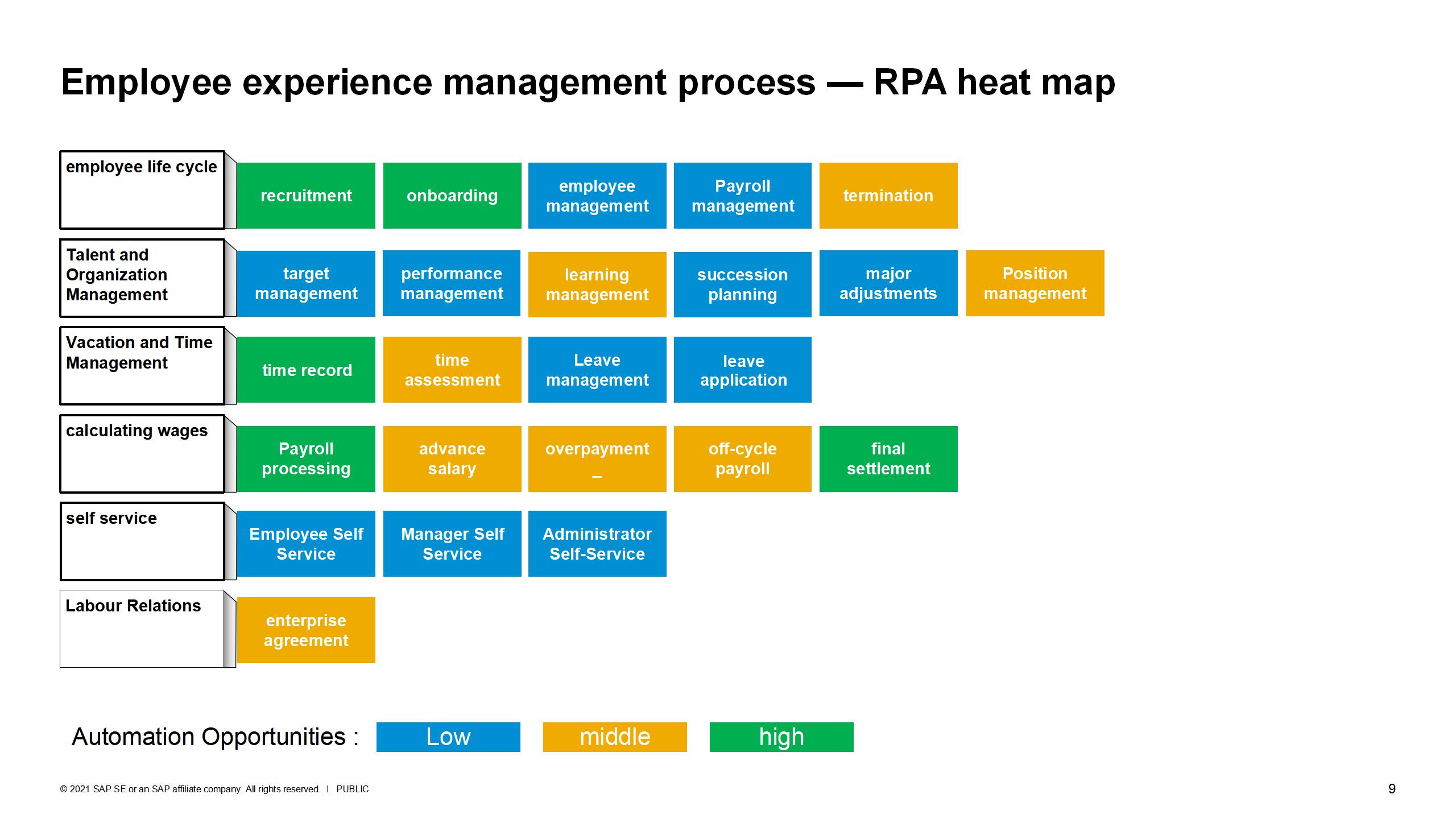 In the end-to-end business process of employee experience management, how to automate processing through RPA, the blue template indicates that SAP is not suitable for processing, the yellow module indicates that there is room for exploration in RPA, and the green module indicates that RPA is very suitable for processing. For example, in the field of recruitment, resume distribution and candidate background checks, SAP RPA can help streamline the entire recruitment process.
In the end-to-end business process of employee experience management, how to automate processing through RPA, the blue template indicates that SAP is not suitable for processing, the yellow module indicates that there is room for exploration in RPA, and the green module indicates that RPA is very suitable for processing. For example, in the field of recruitment, resume distribution and candidate background checks, SAP RPA can help streamline the entire recruitment process.
10.Application of SAP RPA in various industries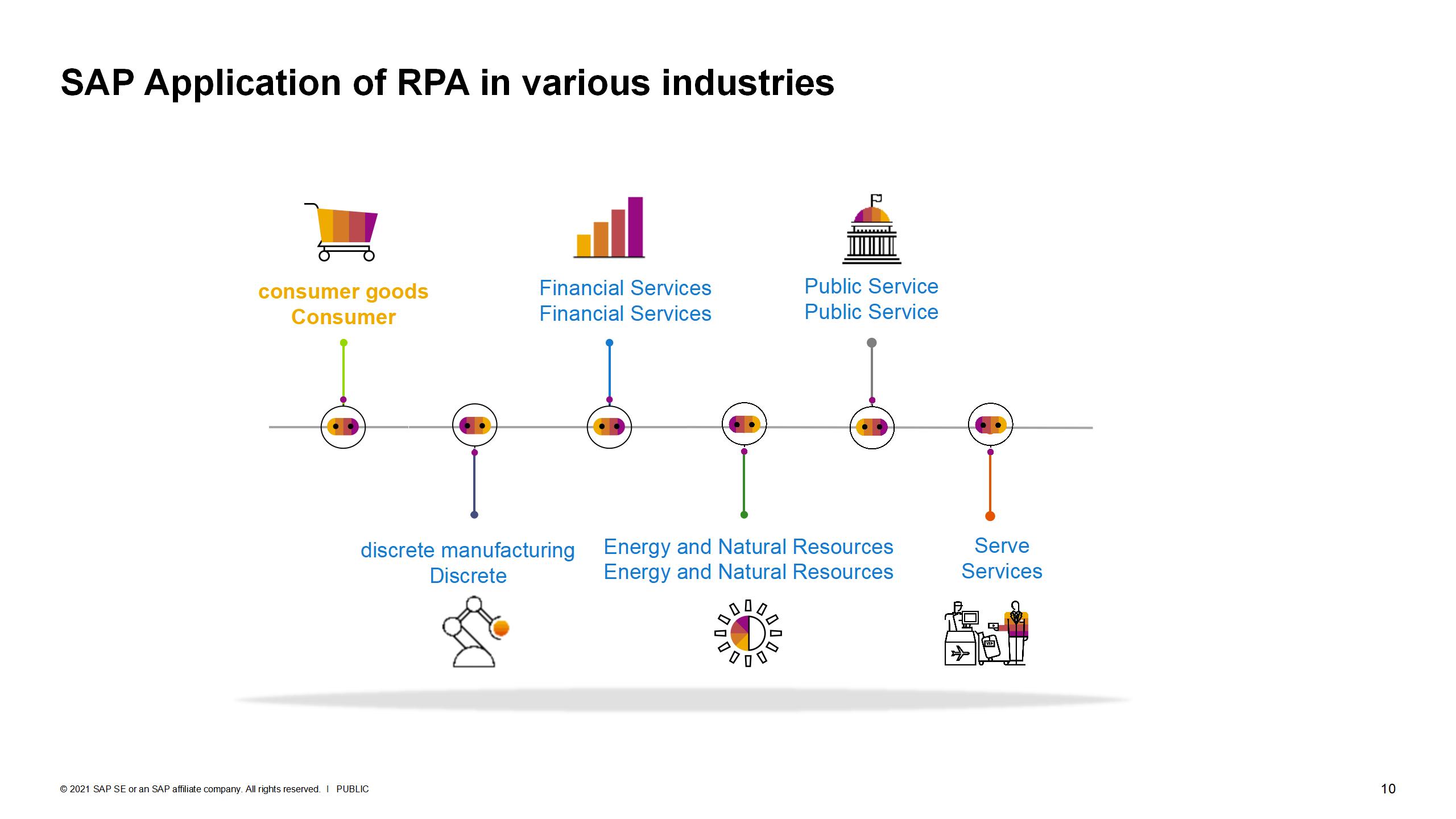 In addition to its application scenarios in different business fields, SAP iRPA also has many applicable application scenarios in various industries. There are many typical applications in consumer goods, financial services, public services, discrete manufacturing, energy and natural resources, services, etc.
In addition to its application scenarios in different business fields, SAP iRPA also has many applicable application scenarios in various industries. There are many typical applications in consumer goods, financial services, public services, discrete manufacturing, energy and natural resources, services, etc.
11. Industry Robot Business Process-Promotion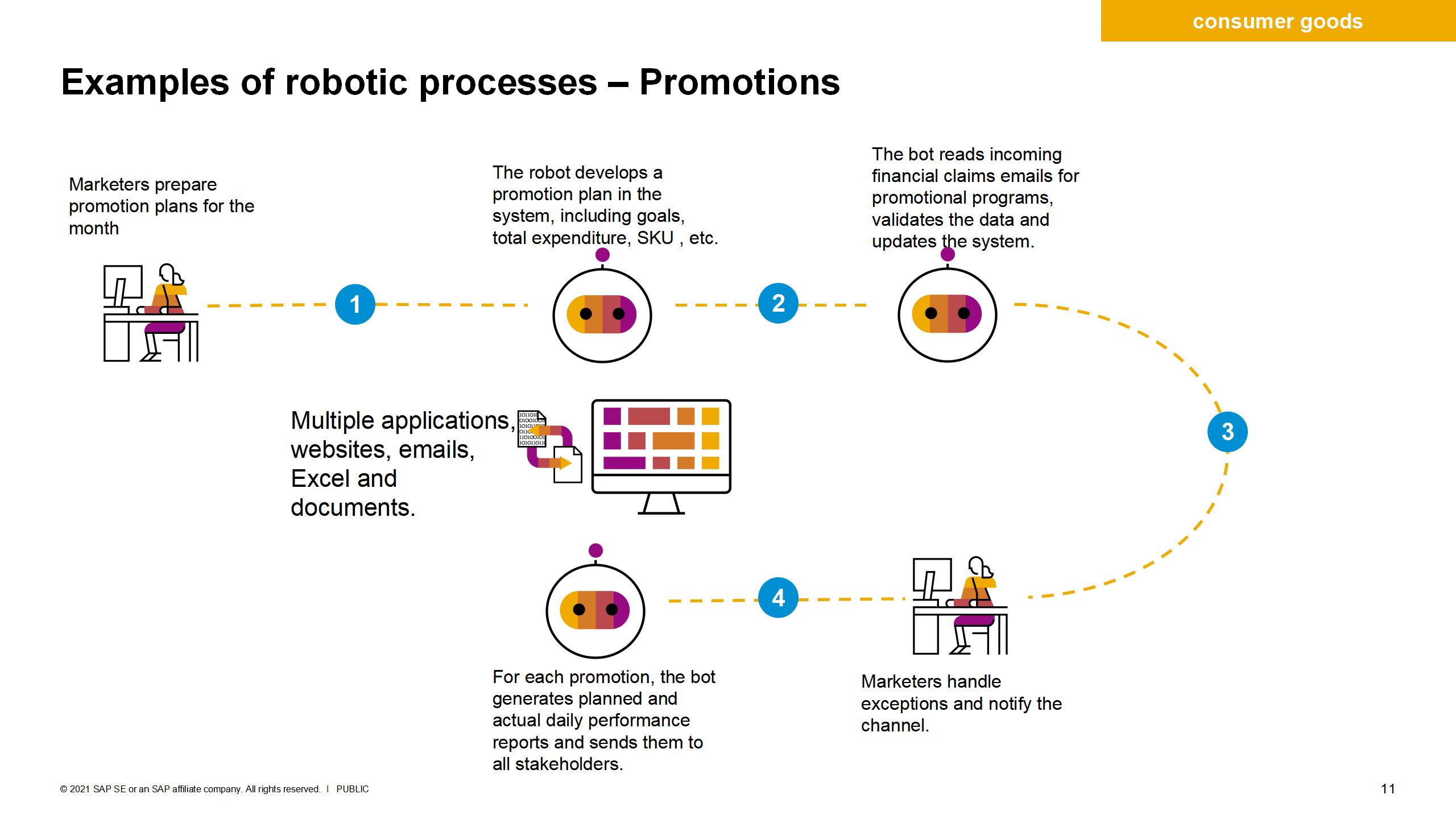 Taking the promotion process in the consumer goods industry as an example, marketers prepare a promotion plan for that month and can use multiple robots to complete this promotion task. Just provide the promotion plan as the input source of information to the robot, and the robot can automatically and systematically help the company maintain the promotion plan of the month, and after verifying the data and updating the system for financial claim emails, notify the marketing personnel for abnormal processing and adjustment. After each promotion is completed, the robot will extract and integrate the information of the entire omni-channel, and send it to the relevant marketing personnel, and the manual only needs to do more valuable upper-level strategic analysis.
Taking the promotion process in the consumer goods industry as an example, marketers prepare a promotion plan for that month and can use multiple robots to complete this promotion task. Just provide the promotion plan as the input source of information to the robot, and the robot can automatically and systematically help the company maintain the promotion plan of the month, and after verifying the data and updating the system for financial claim emails, notify the marketing personnel for abnormal processing and adjustment. After each promotion is completed, the robot will extract and integrate the information of the entire omni-channel, and send it to the relevant marketing personnel, and the manual only needs to do more valuable upper-level strategic analysis.
12. Robot business process-automatic collection of online data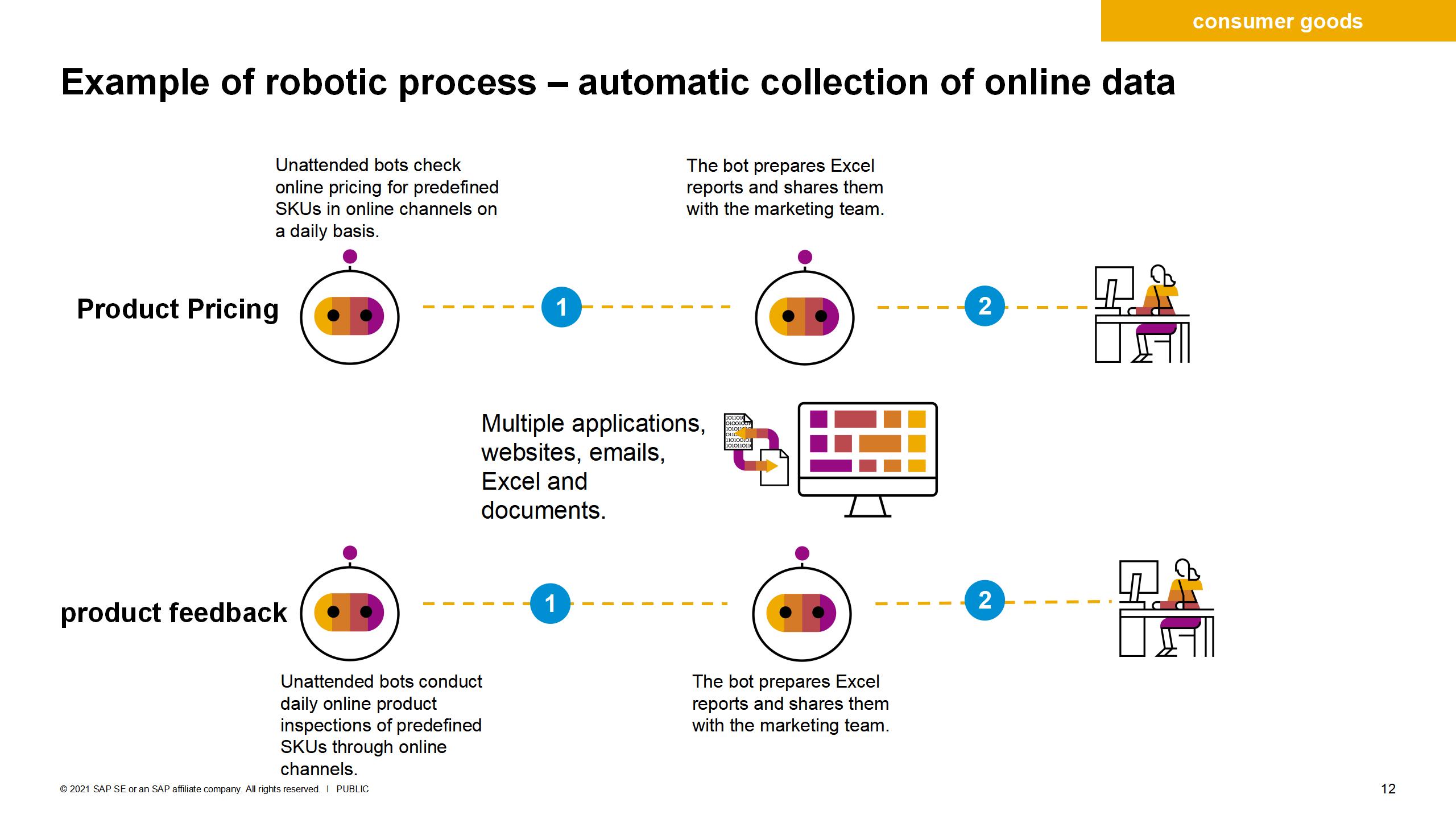 Also take the automatic collection process of online data in the consumer goods industry as an example. Due to the increasing number of online consumption, most of the pricing and feedback data of products in the consumer goods industry are extracted online. The amount of data is large, so manual extraction is very time-consuming. Enterprises can use unattended robots to check the SQ pricing in online channels every day, and fill in the relevant forms with the extracted pricing, and then send it to relevant personnel by email or SMS. Subsequent processing. All in all, the characteristics of RPA also cover the integration and extraction of large-scale data, and automatic processing of cross-platform and flexible serial data through RPA.
Also take the automatic collection process of online data in the consumer goods industry as an example. Due to the increasing number of online consumption, most of the pricing and feedback data of products in the consumer goods industry are extracted online. The amount of data is large, so manual extraction is very time-consuming. Enterprises can use unattended robots to check the SQ pricing in online channels every day, and fill in the relevant forms with the extracted pricing, and then send it to relevant personnel by email or SMS. Subsequent processing. All in all, the characteristics of RPA also cover the integration and extraction of large-scale data, and automatic processing of cross-platform and flexible serial data through RPA.
13. SAP iRPA typical case sharing Taking SAP service customer Wanhua Chemical as an example, it hopes to help enterprises automatically generate and integrate financial statements through SAP intelligent business process robots, so as to improve the overall financial operation efficiency. In the delivery process, first of all, HelpKore optimized the business process, reducing the 12 steps that originally required manual generation of financial statements to 2 steps, and only needed to start the robot, so that the robot could execute it automatically. The delivery of 5 RPA robots can help Wanhua Chemical to save more than 4,000 hours of man-hours each year, and the robots can improve the efficiency of manual operations by more than 50% on average.
Taking SAP service customer Wanhua Chemical as an example, it hopes to help enterprises automatically generate and integrate financial statements through SAP intelligent business process robots, so as to improve the overall financial operation efficiency. In the delivery process, first of all, HelpKore optimized the business process, reducing the 12 steps that originally required manual generation of financial statements to 2 steps, and only needed to start the robot, so that the robot could execute it automatically. The delivery of 5 RPA robots can help Wanhua Chemical to save more than 4,000 hours of man-hours each year, and the robots can improve the efficiency of manual operations by more than 50% on average.
As an emerging thing, RPA robots have become an inevitable trend applied in future business scenarios. Enterprise internal management is moving towards the road of "value-added". Using RPA technology to realize business process automation and intelligent management, SAP iRPA intelligent robots can help enterprises Simplify operations, reduce manual errors, improve compliance, and truly reduce costs and increase efficiency.
Disclaimer: This article is an original article, and the copyright belongs to the author; the public platform of Decision welcomes the submission of original and good articles. If you need to contribute, please send an email to: public@decision-it.com
【Service Guide】
For more information on SAP courses, project consultation and operation and maintenance, please call Decision's official consultation hotline: 400-600-8756
【About Decision】
Global professional consulting, technology and training service provider, SAP gold partner, SAP software partner, SAP implementation partner, SAP official authorized training center. Fifteen years of quality, trustworthy!
▼In order to facilitate further learning and sharing, we have organized and summarized the content of this issue and formed dry information for everyone. We hope that everyone can continue to charge and improve, and continue to accelerate on the path of our beloved SAP career.
Introduction to this issue’s guests:

1. Digital workforce: RPA

Generally speaking, RPA automates some manual operations, including keyboard and mouse operations, such as business operations with high repetitiveness and low added value, thereby accelerating the digital transformation of our business processes. According to the execution mode of RPA robots, it can be divided into three different types:
■ Unattended (digital employee): No human intervention is required, and it can complete tasks assigned to it by the enterprise completely independently and on time.
■ Manned assistant (digital assistant): Collaborate with humans to complete a task, and can start the RPA robot process on demand according to a need of the enterprise.
■ Intelligent duty (hyper-automated employees): By adding artificial intelligence technology to the digital workforce (RPA), robots can learn autonomously based on historical execution data and realize the connection between robots.
2. The expected benefits that SAP iRPA solution brings to enterprises

What expected benefits can the SAP iRPA solution bring to enterprises? Mainly summarized into four aspects:
■ Optimization of corporate human resources: It can help humans handle work, freeing corporate labor to do other more valuable work. At the same time, robots can perform more efficiently and make fewer errors. On the one hand, they reduce labor costs, and on the other hand, they bring To improve work efficiency, we achieve comprehensive optimization of resources.
■ Can realize external connection: a non-invasive way to help enterprises connect systems and data without investing a lot of cost through backend program or interface development to connect system data.
■ Improve user experience: Front-end business can be on duty 24 hours a day through RPA robots to respond to user needs in real time, thereby improving the company's service quality.
■ Standardized auditing: Execute work according to the logical rules designed by the enterprise to avoid any errors caused by external interference. In addition, the execution status of the robot can be recorded in the system, thus improving the efficiency of standardized auditing by the enterprise.
3.SAP iRPA usage area—Shared Service Center

As shown in the figure above, we can see that whether it is shared service process management, financial sharing center, human resources shared services, etc., due to the large amount of data in these fields, clear transaction processing logic is required, and SAP iRPA has very We can highly summarize the scenarios applicable to these fields into four keywords:
■ High repetition: sort out a logical processing rule.
■ Super large amount: When the volume of business process data or execution is large enough and relatively frequent, RPA can be used for automated processing to ensure relatively high input and output.
■ Cross-system: Support enterprises to complete automated business processes across systems and platforms.
■ Multiple integration: When the investment in hardware integration is very large, it is recommended to use RPA to connect soft systems and data.
4.SAP intelligent business process robot

SAP intelligent business process robots mainly cover three core components, which are divided based on a process of implementation and delivery of the entire RPA project:
■ Design side: There is both a desktop development studio installed on the designer’s desktop and a cloud development studio integrated into the cloud robot factory, which further reduces the difficulty of our design.
■ Running end: The desktop execution agent executes according to the demand process set by the enterprise. Whether it is an unattended mode that is started regularly or an attended mode that is started on demand, it can imitate human operations to execute business processes.
■ Management and supervision: Centralized management and supervision of robot execution is called Cloud Robot Factory, which is a SaaS application hosted on the SAP platform.
5.SAP intelligent business process robot technology architecture

The fourth point introduced that the SAP intelligent business process robot is composed of three core components. You can see an architecture of RPA itself in the right frame of the above figure. Simply put, it is a business process that is used as a tool to automate processing, through the UI Interact with APIs and enterprise target programs, such as SAP applications S/4HANA, C/4HANA, etc., non-SAP application third-party tools, the Internet, etc. For Microsoft office application software, by integrating the SDK into RPA, the operation can be performed by calling the SDK without UI capture.
6. Standard RPA template (170+ robots)

The predefined RPA template has successfully launched more than 170 different business process robots, and the predefined RPA is continuously improved and enriched. As shown in the figure above, it covers multiple business lines, including sales, production, supply chain, finance, etc., according to Based on customer usage statistics, these are very typical RPA scenarios.
7. How SAP RPA business applications help various departments

■ Business users: Predefined RPA templates can be used to reduce repetitive and boring manual processes and reduce the trouble caused by manual errors. The simple operation of the same tool can make it easy for users to get started quickly.
■ Company IT department: It can greatly reduce development and implementation risks and improve the input-output efficiency of the entire IT. With such predefined templates, many scenarios can be completed by business users themselves. Subscription and use can also reduce the cost of post-production. maintenance costs.
■ Developers: Based on the pre-configured RPA template, SAP provides source programs for download and use. Enterprises can use the template source code as a development sample, and on this basis, customize development according to requirements, which greatly reduces the risk and difficulty of development.
8.Application of SAP iRPA in different business fields

At present, the application scenarios of SAP iRPA have covered all aspects. The most typical business scenario is the financial field, including business lines from recording to reporting. In addition to finance, as shown in the figure above, procurement, from sourcing to payment, and employee experience management , from recruitment to retirement, customer experience from potential users to collection, travel and expense management, and some tools for small and medium markets, such as B1 and BYD, all have a good support.
9. Employee experience management process

10.Application of SAP RPA in various industries

11. Industry Robot Business Process-Promotion

12. Robot business process-automatic collection of online data

13. SAP iRPA typical case sharing

As an emerging thing, RPA robots have become an inevitable trend applied in future business scenarios. Enterprise internal management is moving towards the road of "value-added". Using RPA technology to realize business process automation and intelligent management, SAP iRPA intelligent robots can help enterprises Simplify operations, reduce manual errors, improve compliance, and truly reduce costs and increase efficiency.
Disclaimer: This article is an original article, and the copyright belongs to the author; the public platform of Decision welcomes the submission of original and good articles. If you need to contribute, please send an email to: public@decision-it.com
【Service Guide】
For more information on SAP courses, project consultation and operation and maintenance, please call Decision's official consultation hotline: 400-600-8756

【About Decision】
Global professional consulting, technology and training service provider, SAP gold partner, SAP software partner, SAP implementation partner, SAP official authorized training center. Fifteen years of quality, trustworthy!











































